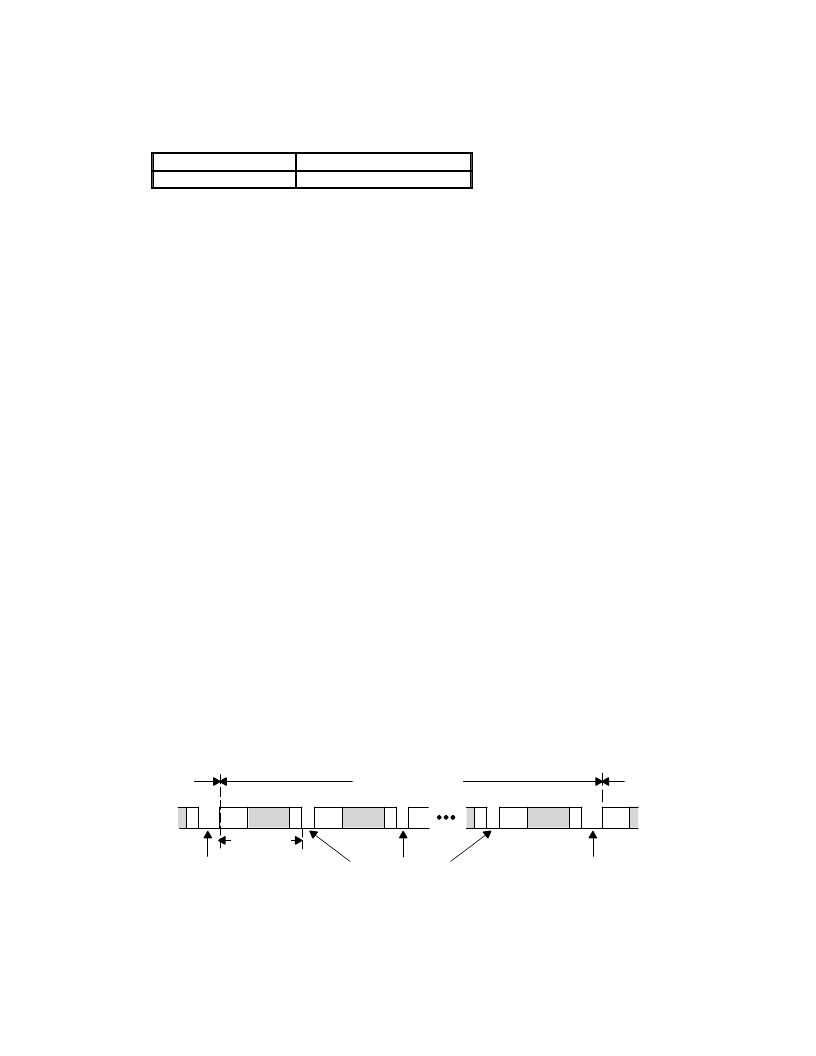- 您现在的位置:买卖IC网 > PDF目录365968 > TSB14C01HV (Texas Instruments, Inc.) 5-V IEEE 1394-1995 BACKPLANE TRANSCEIVER/ARBITER PDF资料下载
参数资料
| 型号: | TSB14C01HV |
| 厂商: | Texas Instruments, Inc. |
| 英文描述: | 5-V IEEE 1394-1995 BACKPLANE TRANSCEIVER/ARBITER |
| 中文描述: | 5V的电机及电子学工程师联合会1394-1995背板收发器/仲裁者 |
| 文件页数: | 31/35页 |
| 文件大小: | 224K |
| 代理商: | TSB14C01HV |
第1页第2页第3页第4页第5页第6页第7页第8页第9页第10页第11页第12页第13页第14页第15页第16页第17页第18页第19页第20页第21页第22页第23页第24页第25页第26页第27页第28页第29页第30页当前第31页第32页第33页第34页第35页

6
–
11
6.3.3
Arbitration Sequence Format
The following format for the arbitration sequence is used:
PRIORITY
ARBITRATION NUMBER
4-bits
6-bits
Each module on the backplane has unique 6-bit arbitration number that is equal to the nodes Physical_ID.
The arbitration number is preceded by four bits of priority. The MSB of the priority field is transmitted first.
The LSB of the priority field is followed by the MSB of the arbitration number.
Dynamic assignment of priority is accommodated.
The lowest priority level (all zeroes) is reserved for fair arbitration, and the highest priority level (all ones)
is reserved for the identification of the cycle start packet.
6.4
Arbitration
Unless a node is using immediate arbitration to access the bus (in which case there is no contention for the bus), it
is possible that more than one node can attempt to access the bus at a given time. Consequently, it is necessary for
a node to arbitrate for the bus in order to gain access to the bus.
NOTE:
A node uses immediate arbitration to send an acknowledge. Since there is no
contention for the bus in this case, arbitration is not necessary. A node that is transmitting an
acknowledge does not arbitrate for the bus, but merely waits for an acknowledge gap to be
detected before it begins transmission. If a node is attempting to gain access to the bus without
using immediate access, it must first arbitrate for the bus.
Arbitration occurs in response to a PHY arbitration request from the link. Nodes begin arbitrating once the bus has
become idle for a predetermined amount of time (the appropriate gap indication occurs). Once this happens, nodes
begin a bit-by-bit transmission of their arbitration sequence.
A node can obtain access to the bus in a limited number of ways. Since some arbitration classes allow nodes to begin
arbitration before others, nodes arbitrating with certain arbitration classes can detect that the bus is busy before they
can begin to arbitrate. In this way, certain arbitration classes can be bypassed, e.g., fair and urgent nodes do not get
a chance to arbitrate when another node is sending an acknowledge.
The backplane environment supports the fair, urgent, and immediate arbitration classes.
6.4.1
Fairness Intervals
The fairness protocol is based on the concept of a fairness interval. A fairness interval consists of one or more periods
of bus activity separated by short idle periods called subaction gaps and is followed by a longer idle period known
as an arbitration reset gap. At the end of each gap, bus arbitration is used to determine the next bus owner. This
concept is shown in Figure 6
–
9.
arb
data
a
a
arb
data
a
arb
a
arb
data
a
arb
Owner A
Owner B
Owner M
Fairness Interval N
Fairness
Interval N
–
1
Fairness
Interval N+1
Subaction Gaps
Arbitration
Reset Gap
Arbitration
Reset Gap
Subaction
Figure 6
–
9. Fairness Interval
The implementation of the fair arbitration protocol is defined in terms of these fairness intervals as is discussed in
the following paragraphs.
相关PDF资料 |
PDF描述 |
|---|---|
| TSB21LV03MHV | IC APEX 20KE FPGA 200K 484-FBGA |
| TSB21LV03CHV | IEEE 1394-1995 TRIPLE-CABLE TRANSCEIVER/ARBITER |
| TSB2203X6MMX30M | IC APEX 20KE FPGA 200K 240-PQFP |
| TSB2204.5X12MMX20M | IC APEX 20KE FPGA 200K 240-PQFP |
| TSB2204.5X19MMX20M | IC APEX 20KE FPGA 200K 240-PQFP |
相关代理商/技术参数 |
参数描述 |
|---|---|
| TSB14C01MHV | 制造商:未知厂家 制造商全称:未知厂家 功能描述:Transceiver |
| TSB14C01PM | 制造商:Rochester Electronics LLC 功能描述:- Bulk |
| TSB15 | 制造商:未知厂家 制造商全称:未知厂家 功能描述:EURO TERMINAL BLOCKS |
| TSB150002DS | 制造商:TE Connectivity 功能描述: |
| TSB150004DS | 制造商:TE Connectivity 功能描述:Conn Europa Terminal Blocks 8 POS 13.5mm Screw ST Cable Mount 40A/Contact |
发布紧急采购,3分钟左右您将得到回复。